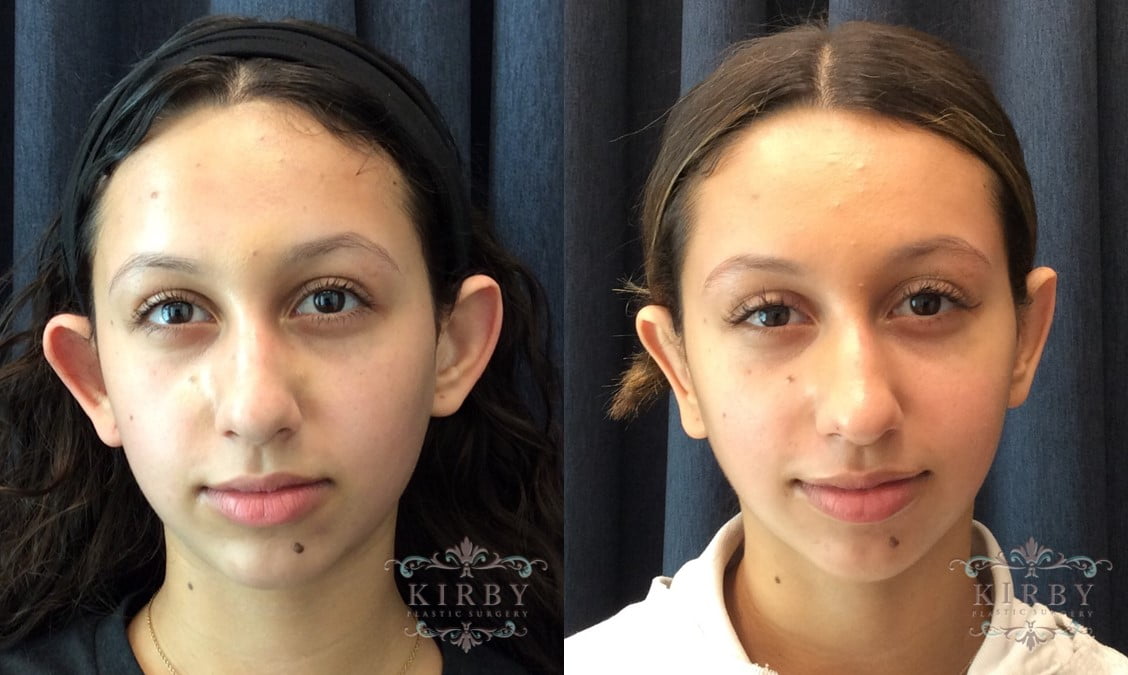Ear Reshaping Surgery Fort Worth

Otoplasty, or ear pinning/reshaping, is a common operation performed to correct prominent ears. Children entering school can benefit greatly from the improved self-esteem this surgery provides. Adults with old ear injuries and children with other ear defects present at birth (“lop ear,” “Stahl’s ear,” “constricted ear,” “cup ear,” or “cryptotia”) are also candidates for otoplasty.
When should otoplasty be performed?
Otoplasty is typically performed between the ages of 4 and 14 years of age. Ears are almost fully grown by age 4, and the earlier the surgery, the less teasing and ridicule the child will have to endure. Ear surgery on adults can also be performed if it was not done as a child.
Parents should remain sensitive to their child’s feelings about protruding ears. Don’t insist on surgery until your child wants the change. Children who feel uncomfortable with their ears and want the surgery are generally more cooperative during the process and are typically happier with the outcome.
Female Plastic Surgeon Fort Worth
- Board-Certified Plastic Surgeon
- Over 12 years of experience in private practice
- Founder and Medical Director of Kirby Plastic Surgery, Kalos Medical Spa, and City Surgery Center—a Quad A-accredited, state-of-the-art facility located onsite
- Specialist in breast surgery and body contouring, including postpartum
- Castle Connolly Top Doctor since 2019
- First female Chief of Plastic Surgery, Texas Health Resources Harris Methodist Hospital

How is otoplasty performed?
One of the more common otoplasty techniques involves a small incision on the back of the ear that allows access to the ear cartilage. The cartilage is sculpted and bent back towards the head. Permanent stitches underneath the skin may be used to help maintain the new shape. Another technique utilizes a similar incision on the back of the ear and a small amount of skin is removed. Stitches are used to fold the cartilage back on itself to reshape the ear without removing cartilage. Sometimes a combination of these procedures is chosen, depending on the specific needs of the ear.
Even when only one ear appears to protrude, surgery is usually performed on both ears for a better balance. In most cases, ear surgery will leave a faint scar in the back of the ear that will fade with time.
Real patient images from Board-Certified Plastic Surgeon Dr. Emily Kirby
*Individual results may vary.

What kind of anesthesia will I have?
If your child is young, general anesthesia is recommended, so the child will sleep through the entire operation. For adults, local anesthesia with intravenous sedation may be preferred.
How long is ear pinning surgery?
The surgery usually takes 1 to 2 hours, although more intricate procedures may take longer. Ear surgery is typically performed as an outpatient procedure in a surgical center.
- Key Benefits
- Glossary
- Adjusts the position of protruding ears
- Creates a proportional ear appearance with the rest of your features
- Provides long-lasting results
- Minimal visible scarring, with incisions hidden behind the ear or within its natural creases
- Antihelix: The inner ridge of the ear’s cartilage, just inside the rim, which is often reshaped or enhanced during otoplasty to create a more natural-looking ear contour.
- Conchal Cartilage: The central part of the external ear, forming the back of the ear bowl, which is sometimes reduced or reshaped during otoplasty to adjust the ear’s protrusion from the head.
- Ear Pinning: A common term for the surgical technique used in otoplasty to pull the ears closer to the head, reducing the appearance of protruding ears.
- General Anesthesia: Medication administered to induce sleep and relaxation during surgery.
- Incisionless Otoplasty: A less invasive form of ear reshaping that uses stitches to alter the ear’s shape without making incisions, suitable for certain types of ear corrections.
- Local Anesthesia: Medication administered to prevent pain during surgery by numbing a small area.
- Otoplasty: A surgical procedure to change the shape, position, or size of the ears, often performed to correct prominent ears or congenital abnormalities.
- Postauricular Incision: An incision made behind the ear, commonly used in otoplasty, which allows the surgeon to access the ear cartilage with minimal visible scarring.
- Prominent Ears: Ears that stick out more than normal from the side of the head, often the primary concern addressed in otoplasty.
- Recovery Time: The period after surgery during which the patient heals. This includes time for swelling and bruising to subside, and for the patient to gradually return to normal activities, typically ranging from a few days to several weeks. Recovery can be streamlined, but not rushed.
- Sutures: Stitches used to hold tissue together or to reshape the ear cartilage during otoplasty.
- Tympanoplasty: A surgical procedure to repair the eardrum or middle ear structures, not to be confused with otoplasty, which is cosmetic and focuses on the outer ear’s appearance.
What are the risks of ear pinning?
Complications of ear surgery are infrequent and are usually minor. Nevertheless, as with any operation, there are risks associated with surgery and specific complications associated with this procedure. The “pinned” ear may revert back to its pre-operative shape. This is not likely, and is more common in adults.
A small percentage of patients may develop a blood clot on the ear. It may dissolve naturally or may require drainage with a needle.
Occasionally, patients may develop an infection in the cartilage, which can cause scar tissue to form. Such infections are usually treated with antibiotics; rarely, surgery may be required to drain the infected area.
How do I prepare for surgery?
Prior to any procedure, it is necessary to review medications you are taking that may affect your surgery. You may be asked to stop or to adjust some medications you are on. As always, it is important to include supplements on your list of medications. Aspirin and aspirin products (Alka-Seltzer®, Carisoprodol, Excedrin®, Goody’s®, Midol®), anti-inflammatory medications (except acetaminophen, or Tylenol®), and herbal supplements must be avoided for 10 days prior to your surgery. Dr. Kirby will discuss your medications with you during a personal consultation. Learn more about which medications and supplements to avoid.
Depending on your medical condition, you may be asked to get lab testing or a medical checkup prior to your surgery. You may also be asked to have an updated mammogram prior to your surgery if you have not had one recently.
Tobacco products impair your body’s ability to heal. You will be asked to stop smoking for 6 weeks prior to any surgery. Tobacco step-down products such as chewing gum and Nicoderm continue to provide your body with tobacco and must be stopped as well. Please ask Dr. Kirby if you will need assistance with quitting.
Be sure to arrange for a responsible adult to drive you to and from your surgery. You will need someone to stay with you the night following your surgery as well.
You will receive specific instructions for your surgery day from Dr. Kirby’s office.
“She was not only professional, reassuring, and confident, but also friendly.“
What is recovery from otoplasty like?
Adults and children are usually awake and walking around within a few hours of surgery. The head will be wrapped in a bulky bandage immediately following surgery to ensure the best molding and healing of the ear(s). The ears may throb or ache for a few days, but this can be relieved by oral pain medication. Within a few days, the bulky bandages will be replaced by a lighter head dressing similar to a headband. Be sure to follow the directions for wearing this dressing, especially at night. Stitches are usually removed, or will dissolve, in about 1 week.
Any activity in which the ear might be bent should be avoided for approximately one month. Most adults can go back to work about 5 days after surgery. Children can go back to school after a week or so, if they’re careful about playground activity. You may want to ask your child’s teacher to keep an eye on the child for a few weeks.
References »
Papadopulos NA, Niehaus R, Keller E, Henrich G, Papadopoulos ON, Staudenmaier R, Kovacs L, Peter Herschbach, Pototschnig H, Machens HG. The Psychologic and Psychosocial Impact of Otoplasty on Children and Adults. J Craniofac Surg. 2015 Nov;26(8):2309-14. doi: 10.1097/SCS.0000000000001990.
Handler EB, Song T, Shih C. Complications of otoplasty. Facial Plastic Surgery Clinics of North America. 2013 Nov;21(4):653-62. doi: 10.1016/j.fsc.2013.08.001.
Siegert R, Magritz R. Otoplasty and Auricular Reconstruction. Facial Plastic Surgery & Aesthetic Medicine. 2019 Aug;35(4):377-386. doi: 10.1055/s-0039-1693745.
Hoshal SG, Morisada MV, Tollefson TT. Reducing Surgical Risks for Otoplasty. Facial Plastic Surgery Clinics of North America. 2023 May;31(2):253-261. doi: 10.1016/j.fsc.2023.01.011.
Ordon A, Wolfswinkel E, Shauly O, Gould DJ. Aesthetic Otoplasty: Principles, Techniques and an Integrated Approach to Patient-Centric Outcomes. Aesthetic Plastic Surgery. 2019 Oct;43(5):1214-1225. doi: 10.1007/s00266-019-01441-2.
Stewart KJ, Lancerotto L. Surgical Otoplasty: An Evidence-Based Approach to Prominent Ears Correction. Facial Plastic Surgery Clinics of North America. 2018 Feb;26(1):9-18. doi: 10.1016/j.fsc.2017.09.002.
Dr. Emily Kirby uses Enhanced Recovery After Surgery (ERAS) protocols, also known as “multimodal analgesia,” to minimize recovery time, and we see real results: our patients experience less nausea and feel more alert, mobile, and comfortable after their procedures.
“I had very hard recoveries in the past…it took me weeks to get back to caring for my family. With Dr. Kirby, I had a wonderful recovery and was back to my activities surprisingly quickly. Don’t tell the doctor, but I was at my child’s sporting event the day after my surgery, and I felt great!”
—Real patient of Dr. Kirby
- Discuss your goals and concerns
- Obtain a unique female perspective
- Review convenient financing options
- call or TEXT (817) 292-4200 or contact us today!
Area Served:

Medically reviewed by Dr. Emily J. Kirby — Updated on Apr 15, 2024